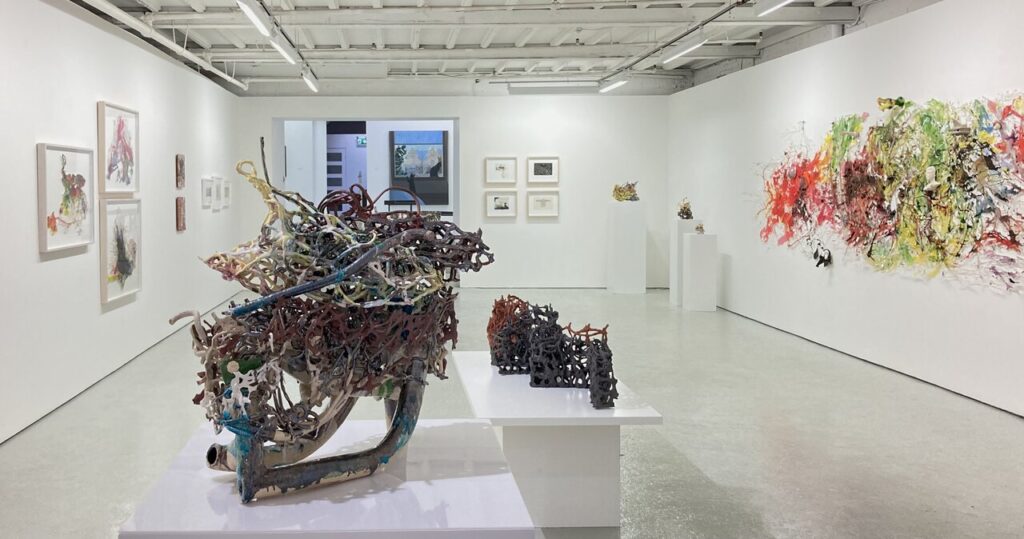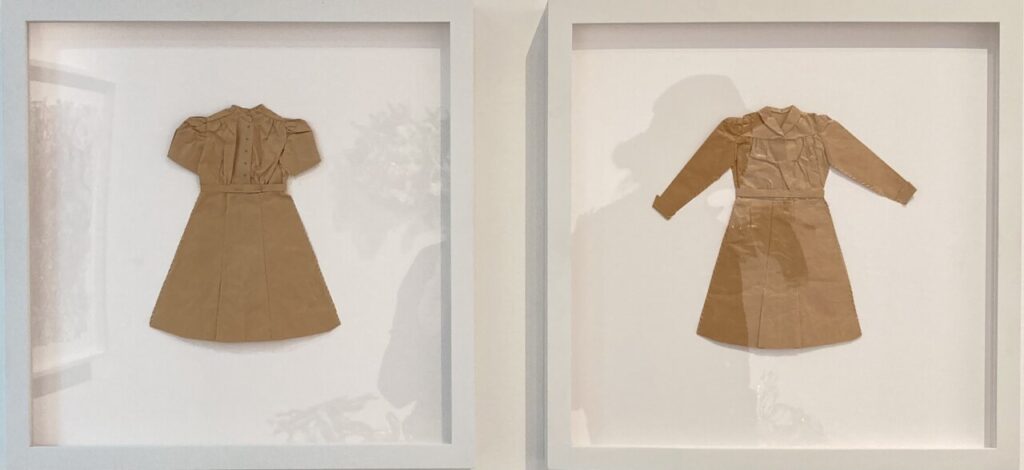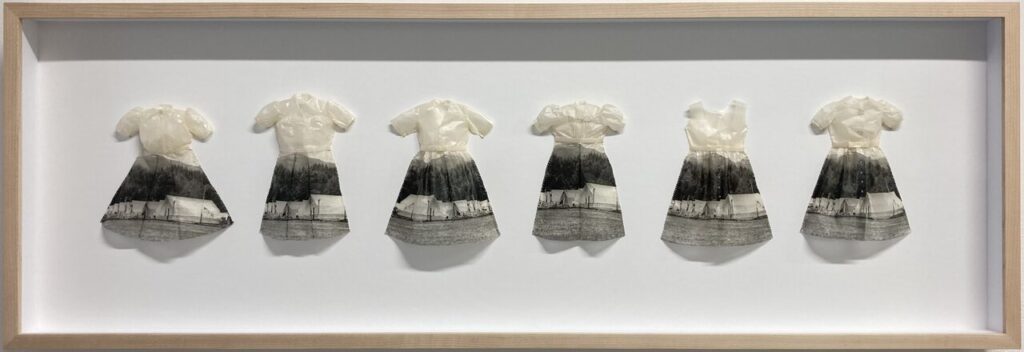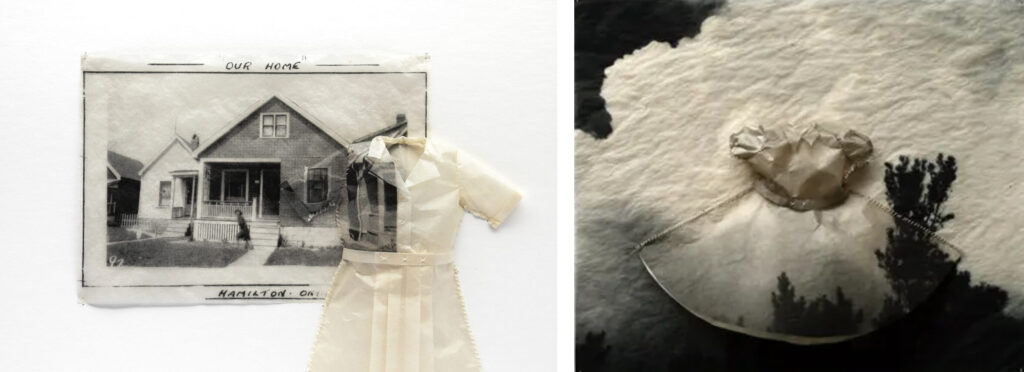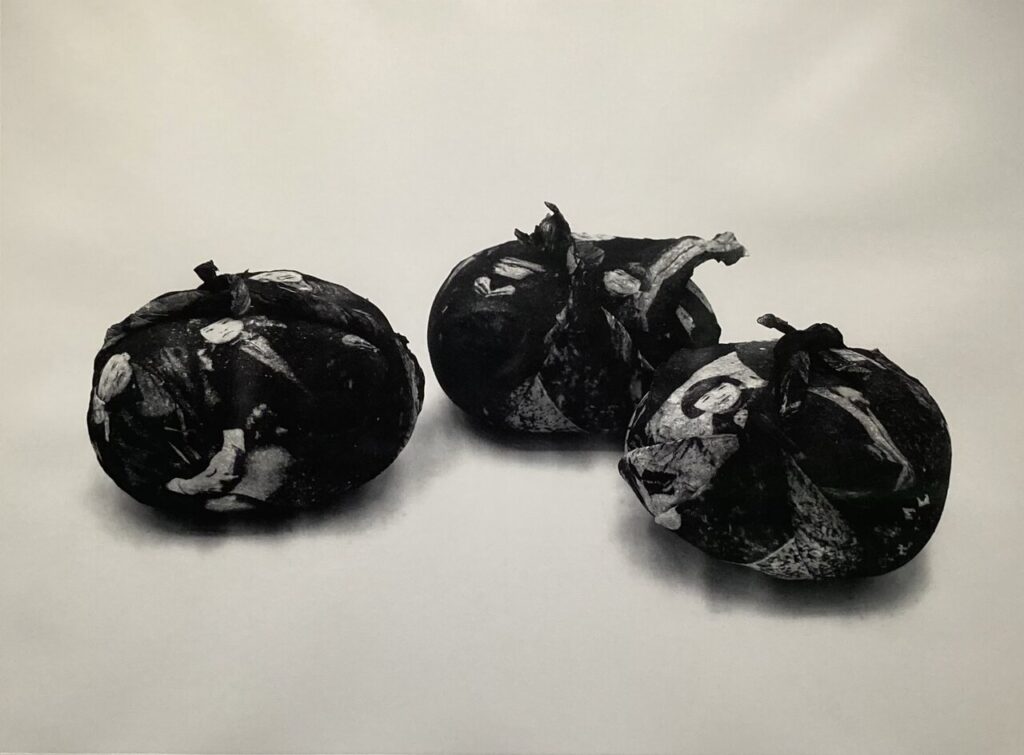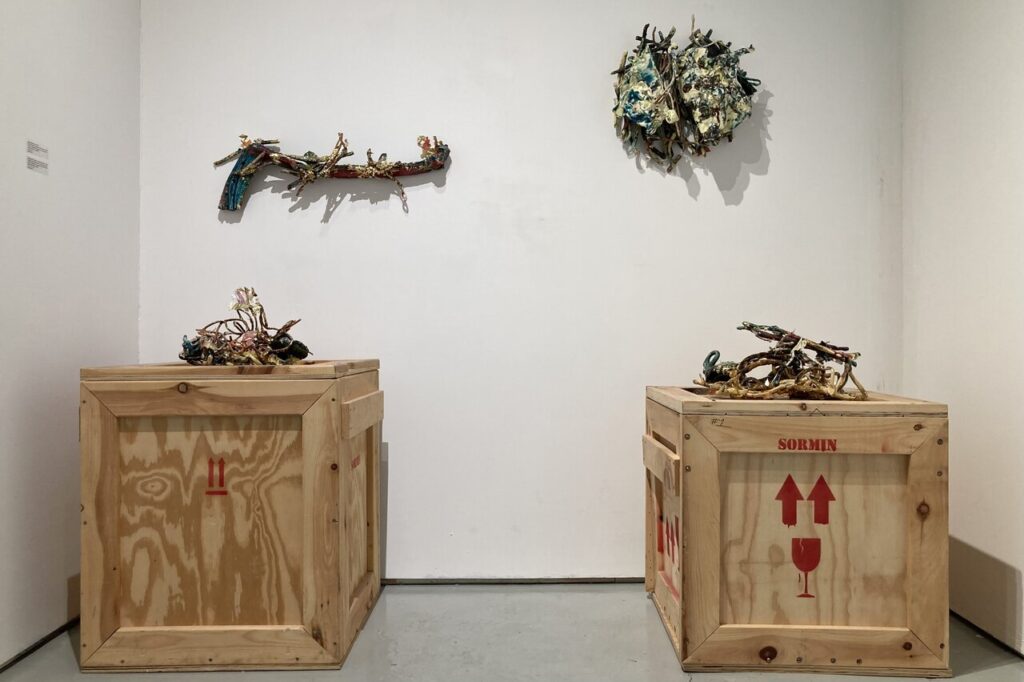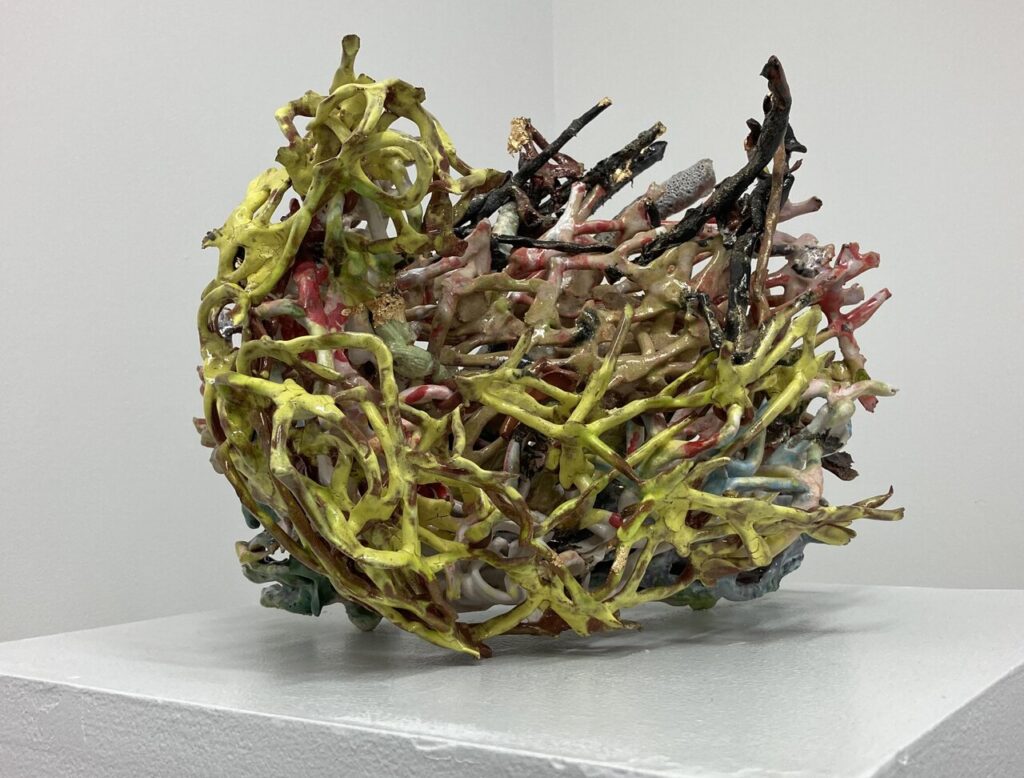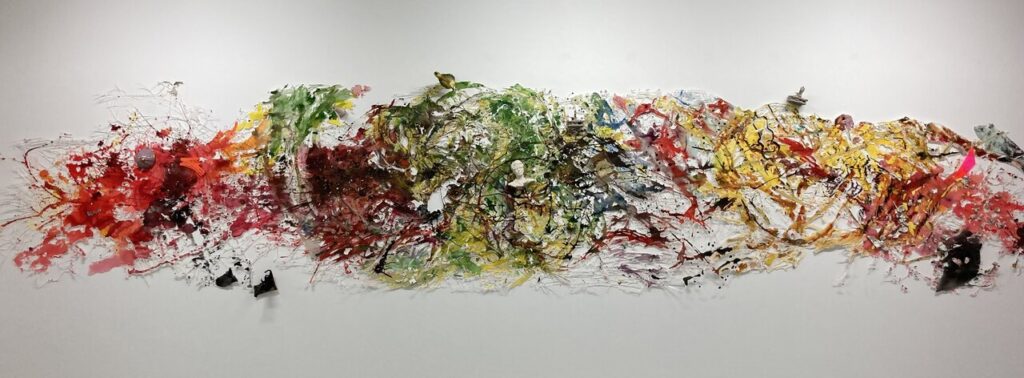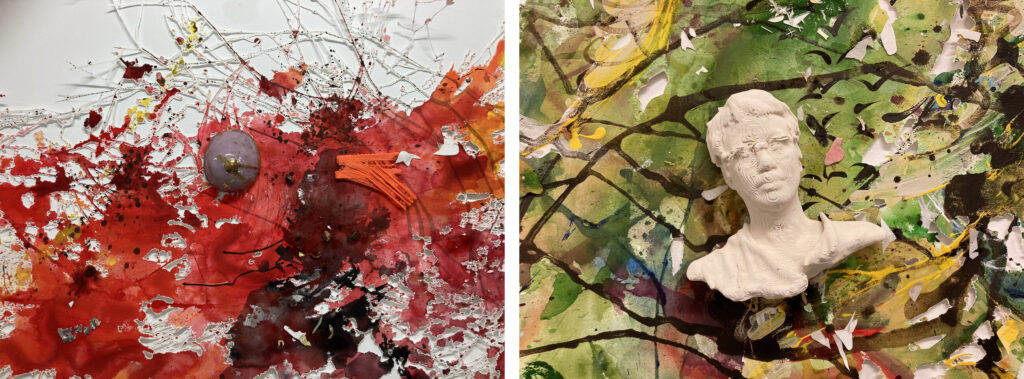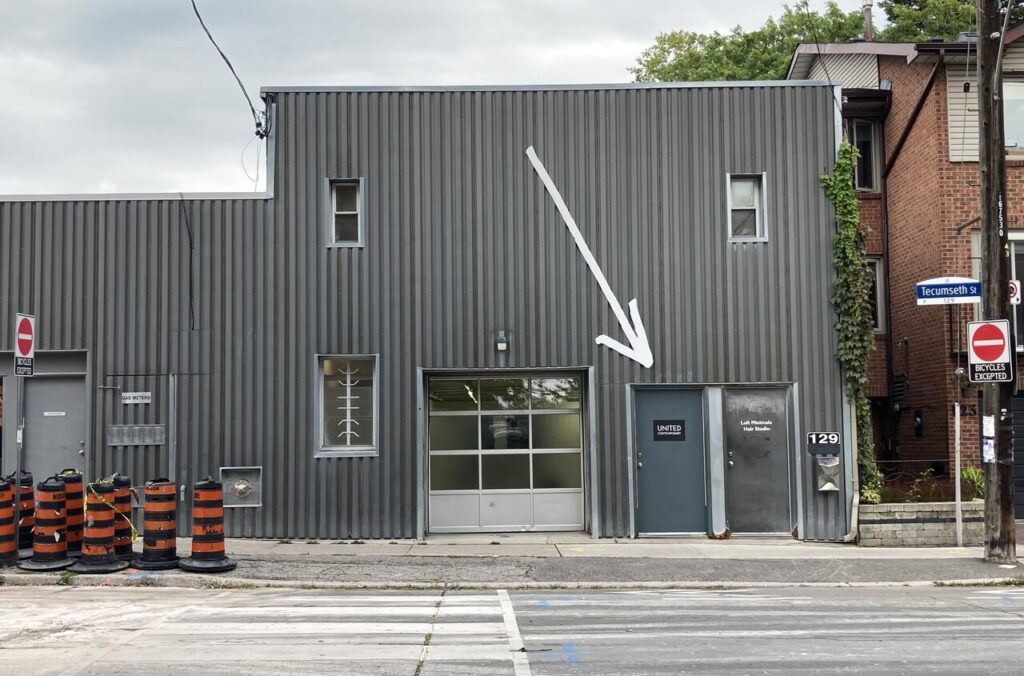How can we sufficiently remember memories that are not our own, that we have inherited? How can we embrace cultural history holistically? Emma Nishimura and Linda Sormin seek to address these questions in Gestures of Remembering at United Contemporary. The exhibition includes Nishimura’s intricate explorations of how internment camps have marked the Japanese community. While Sormin contemplates familial history, as affected by organic cultural development, colonization, and the individual experience. Gestures of Remembering also reflects upon the artists’ return to sources that previously inspired them and how they’ve changed their practice through experimentation in media.
Exhibition view of Gestures of Remembering at United Contemporary. Photo: Rashana Youtzy
I was captivated by the miniature dresses in frames along the wall. Each of the dresses has a unique design, carefully stitched together out of paper. The paper contains black and white archival images or text. The sewn paper works are Nishimura’s effort to understand the effect of internment camps on the Japanese community. The dresses are a return to the motif that inspired Nishimura in graduate school, borne from the patterns created by her grandmother. Works such as those in “Shikata ga nai: It cannot be helped” (2024) are delicate and can fit in one’s palm. The surface of each varies: trees, a home, a crowd of faces.
Nishimura’s Grandmother’s Dresses (above) and Emma Nishimura, Shikata ga nai: It cannot be helped, 2024, photo etching with gampi with thread, framed, 19 x 33.75 inches (below). Photo: Rashana Youtzy
They represent the fundamental components of a community— environment, shelter, people. Nishimura’s memorializing of these moments and people are careful remembrances of culture. Remembrance is also found in the texts featured in the works, transcriptions of interviews about experiences in internment camps and how they have affected the community.
Emma Nishimura, Federick Avenue, 2024, photo etching on gampi with thread, framed in natural wood, 14 x 17 inches (left) and Seeking Solace, 2023, photogravure etching with thread, framed, 14 x 15 inches (right). Images are courtesy of United Contemporary
Nishimura focuses on what goes unsaid, memories unknown, lost, or have not been shared, though inherited either way. These placeholders are evident in the space in the furoshiki-wrapped bundles (method of packing small goods in Japan). Within the back gallery are more bundles, tucked under a barrier and upon a plinth. One can recognize varying faces, hands folded together, and glimpses of landscapes in monochrome within “An Archive of Rememory” (2016-2024). Those same bundles are the subject of “Generations of an Archive I”, a large photograph showcasing slightly shifting angles of the furoshiki. This presents a fragmented sort of visibility — a distortion of what is known— but also presents a different way of knowing. As a result, like the memories or the experiences discussed, we are privy to alternative perspectives that add another layer to how they are remembered.
Emma Nishimura, Generations of an Archive I, 2022, photo etching on hahnemuhle paper, framed in bleached maple, 30 x 40 inches. Photo: Rashana Youtzy
The interconnection between generations in a culture takes on a more literal representation in Sormin’s works. Throughout the gallery are various sculptures in the form of webs, scrolls, and multimedia works. The web sculptures are polychrome with layers upon layers of glaze.
Installation view with Linda Sormin’s works. Photo: Rashana Youtzy
Works such as “Sup-sohn (complexity)” (2019) are tantalizing, what would it be like to hold them in one’s hands to experience their tactile form? What would it be like to carry them outside and hear the wind blow through their gaps? The back gallery contains more sculptures, placed upon crates rather than plinths. These substitutes in display recognize the transient nature of constantly shifting and evolving, both as an artist and as a culture.
Linda Sormin, Sup-sohn (complexity), 2019, glazed ceramics, found shards, epoxy, gold leaf, 12 x 14 x 12 inches. Photo: Rashana Youtzy
The crescendo of Sormin’s work is “Origin Myths”, spanning an entire wall and consisting of paper, ceramics, paint, and filament. In one section there is a shattered French bust, the fragments scattered within the lower right portion of the expansive work. Hidden among the shards is a tiger, a formidable foe though not exempt from extinction. Can culture recover from being endangered? Among the splatters of colour are more sculptural details such as a mauve breast with a gold nipple, orange tracks of filament prints, and a 3-D printed bust of the artist. The careful insertions of these objects prompts one to reflect on their inclusion: to be nurtured and grow in another land, accessing privilege others are deprived of; the artifice one feels in engaging with their ‘motherland’ though living elsewhere; inserting oneself into the cultural fabric to better understand who they are. Both Nishimura and Sormin recognize the difficulty in knowing two worlds, recognizing the gaps in understanding due to the inability to exist in both simultaneously. This does not necessarily reflect a shallow understanding, solely that there will be tethers and connections, but not a solid whole.
Linda Sormin, Origin Myths, 2024, hand-cut watercolour and graphite, resin, ceramic and acrylic shards. 56 x 265 inches (above) and details (below). Photo: Rashana Youtzy
Nishimura’s and Sormin’s reckoning with cultural history have created a space for dialogue beyond suffering as the focal point. Their priorities are clear in making space for experiences, adapting to persist, and creating anew with what has been inherited. Further, both artists have grown technically, expanding in their painting, paper works, and sculpture processes. Gestures of Remembering is an attestation of their embrace of new modes of creating, recognizing the amalgamation of the self, and the legacies within cultural communities.
On the note about making space, recognizing the community, and opportunities for growth, Gestures of Remembering is a fitting exhibition for United Contemporary to break in their new location. When discussing the move with gallery director Melanie Trojkovic, she shared that United is thrilled with the space and opportunities to grow. The location is three times the size of their previous gallery, presenting better storage and more opportunities for programming. The Tecumseth location is also in closer proximity to downtown, which has meant greater foot traffic and integration within the community. United’s move has also brought a new energy to the former Birch Contemporary space, with the team enthusiastically embracing the move into their dream location and new chapter in their evolution.
The entrance of United Contemporary at 129 Tecumseth Street
Rashana Youtzy
*Exhibition information: Gestures of Remembering, August 22 – September 28, 2024, United Contemporary, 129 Tecumseth Street, Toronto. Gallery hours: Wed – Sat 11 am – 6 pm.

